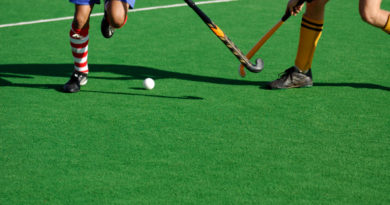Common hockey injuries to look out for
Field hockey is one of the most intense and physically demanding sports there is with it’s breakneck pace and dizzying twists and turns.
Hey, it’s why we love it, but it carries risks too with injuries not unusual. Here we look at the most common hockey injuries to look out for.
Ankle Sprains
Forget hockey, ankle sprains are probably the most common injury in sport with NBA players perhaps the worst affected owing to the movements involved in their sport. Heck, even horses among Twinspires Kentucky Derby contenders can suffer from ankle sprains! Anyway, we’re afraid these injuries plague field hockey too.
Turns are considered one of the movements that cause such injuries with the outside of your ankle likely to be the side suffering the problem as the ankle ligaments overstretch.
You won’t necessarily see any signs immediately with swelling and soreness sometimes only coming to the fore hours after the event.
The sooner you notice an issue, the better because compression of the wound can reduce swelling and aid recovery massively.
Projected time out – 1 to 3 weeks
Facial injuries
Let’s be clear, when we talk about facial injuries we are generally speaking of soft tissue wounds like cuts rather than head injuries and concussions, which require more specialist attention as Raul Jimenez of Wolverhampton Wanderers football club found out a couple of weeks ago.
Unfortunately, with high intensity and sticks combined, facial injuries happen all the time. There isn’t much you can do to avoid them so being clued up on how to deal with them when they do occur is useful.
If you think there is a break – which is unfortunately one of the more common injuries with jaws and noses rather common war wounds – then it’s medical attention for you. Where cuts and scrapes are concerned, just make sure they’re kept clean.
Projected time out – varies wildly depending on the injury. Some can return to action immediately
Groin Pain
We’re back to another injury caused by all those directional changes. Groin pain is one of the most regular complaints of hockey players with the area susceptible to injury through constant twists and turns due to ‘wear and tear’ or as a one of moment of overexerting the body.
Generally speaking, it’s rare to get any searing pain to alert you to such an injury with pain gradually developing as you go through ‘gate movements’. Unfortunately, accurate diagnosis of groin pain does usually require specialist help.
Projected time out – four to six weeks
Shin Splints
Shin splints is something that plenty of hockey players will have come across in their time. If you’re lucky enough to have avoided this sort of injury then count yourself fortunate.
The reasons behind shin splints – medically referred to as medial tibial stress syndrome – are largely unknown with a lot of it boiling down to pure luck.
Based on what is known about the injury, one of the biggest contributing factors is believed to be the playing surface; given the number of artificial pitches involved in field hockey nowadays the risk is heighted.
Projected time out – Unknown. It’s a case of resting and adjusting your training routine to reduce the stress put through your shins
Anterior Cruciate Ligaments
We close with one of the nastiest injuries an athlete can suffer, the cruciate. There are two cruciate ligaments around the knee joint but the posterior is less commonly impacted through sporting activity.
The bad news doesn’t really stop coming with the anterior or ACL – as it’s commonly known – either. Firstly, it shows no warning signs and 99 times out of 100 the injury occur in completely innocuous circumstances with, yep you guessed it, that old foe of turning that poses the biggest risk.
The other side of bad news is that it takes a long time to recover from it if it does go.
If you’re a male the bad news is over. If you’re a female, we’re afraid you are up to 10 times more likely to suffer an ACL injury.
Projected time out – 12 months. You can read reports of quicker returns but the risk of secondary breakdown is heightened.
There you have it, the most common field hockey injuries. Take protective measures, wear the correct gear and stay safe while practising.




